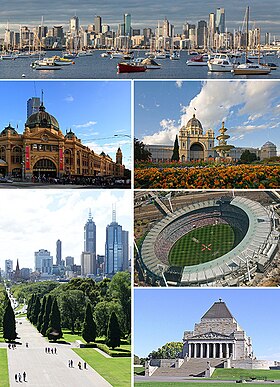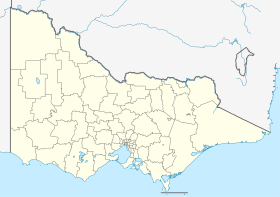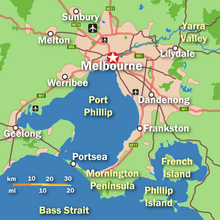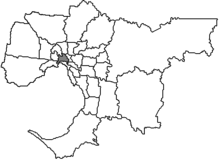Melbourne
| Melbourne | |||||||
|---|---|---|---|---|---|---|---|
 Melbourne skyline at night (pictured above), Flinder Street Station (center right), Royal Exhibition Building, Shrine of Remembrance, MCG (pictured below) |
|||||||
|
|||||||
|
|||||||
|
|||||||
|
|||||||
|
|||||||
|
|||||||
|
|
|||||||
Melbourne [ ˈmɛɫbən ] is the capital of the state of Victoria in Australia . With 4.3 million inhabitants, it is the second largest city on the Australian continent after Sydney (as of 2018). Melbourne residents are called Melburnians in English . Melbourne was named after the then British Prime Minister Lord Melbourne in 1837 and is the seat of both Catholic and Anglican archbishopric.
The agglomeration consisting of the core city of Melbourne City with around 136,000 inhabitants (as of 2016 census) and 30 other municipalities is the most important economic, cultural and political center of Victoria. The city's population is largely made up of immigrants who include are of Chinese, British, Greek, Italian, Irish, Croatian or Vietnamese origin.
geography
Geographical location
The city is located on the Yarra River in the south-east near its confluence with Port Phillip Bay, an average of 14 meters above sea level . The urban area ( Urbanized Area ) has an area of 1705 square kilometers.
The metropolitan area ( Melbourne Statistical Division ) has an area of 8830 square kilometers. It extends from north to south for about 70 kilometers and from east to west for about 50 kilometers. The geographic coordinates are 37.49 degrees south and 144.57 degrees east. This makes Melbourne the southernmost metropolis in the world .
There are 31 Local Government Areas (LGAs) in the city of Melbourne . These Metro Councils make up the Greater Melbourne Region . 3.6 of the 4.9 million inhabitants (as of 2006) of Victorias live here. The 26 Cities are also referred to as the Metropolitan Area , the five Shires as the Outer Metropolitan Area of Melbourne.
The central CBD City of Melbourne in the city center plays a special role , whose head bears the title Lord Mayor (otherwise only Mayor ) and who represents the city of Melbourne to the outside world.
City structure
Geographically differentiates the city center ( Inner City ) and the northern, eastern, southeastern and western suburbs ( English : Suburbs ). Melbourne is also geographically made up of 217 districts, some of which overlap with the LGA.
|
|
climate
Melbourne is in the temperate climate zone . The average annual temperature is 14.9 ° C. The warmest month is February with an average temperature of 20.2 ° C, the coldest month is July with an average of 9.7 ° C. The highest temperature ever recorded in Melbourne was recorded at 46.4 ° C on February 7, 2009, the lowest at −2.8 ° C on July 21, 1869.
The mean annual rainfall is 649.8 millimeters. Most of the precipitation falls in October with an average of 66.1 millimeters, the lowest in January with an average of only 47.3 millimeters.
The weather in Melbourne is very changeable and will be happy with "four seasons in a day" (German Four seasons in one day described). Strong weather fluctuations can be observed especially from spring to summer. They manifest themselves primarily in the form of storms, rain and rapid temperature drops. This is due to the temperature difference between the cool South Pacific Ocean and the considerably warmer inland of Australia. If the country warms up significantly faster than the South Pacific, the air rises over the land. The colder air from the sea moves as a southerly wind, even Southerly called to the northern area of high pressure. This creates a cold front that causes the sudden change in weather. In summer, very warm winds flow from the center of the continent to Melbourne, as a result of which temperatures rise sharply. During one such situation, Melbourne recorded maximum daily temperatures of over 40 degrees Celsius for three consecutive days in February 2009, which led to the 2009 bushfires in Victoria in the surrounding area .
During the winter months, Melbourne is cooler than other Australian capitals (with the exception of Hobart ). Snow occurs very rarely, frost and fog occasionally.
The following table shows the average climate values from 1855 to 2013:
| Melbourne | ||||||||||||||||||||||||||||||||||||||||||||||||
|---|---|---|---|---|---|---|---|---|---|---|---|---|---|---|---|---|---|---|---|---|---|---|---|---|---|---|---|---|---|---|---|---|---|---|---|---|---|---|---|---|---|---|---|---|---|---|---|---|
| Climate diagram | ||||||||||||||||||||||||||||||||||||||||||||||||
| ||||||||||||||||||||||||||||||||||||||||||||||||
|
Average monthly temperatures and rainfall for Melbourne
Source: Australian Bureau of Meteorology : Melbourne Regional Office Station. Observation period: 1855–2013 (hours of sunshine 1955–1967). Retrieved December 27, 2013.
|
|||||||||||||||||||||||||||||||||||||||||||||||||||||||||||||||||||||||||||||||||||||||||||||||||||||||||||||||||||||||||||||||||||||||
history
The area of today's city of Melbourne had been populated by almost 20,000 Aborigines for about 35,000 years , who belonged to the three tribes of Wurundjeri , Boonwurrung and Wathaurong and together formed the association of the Kulin nation. For them the area was an important meeting point and was also an important source of water and food. In 1803 the area was first explored by Europeans and in 1835 European settlers settled from Tasmania and named the bay Port Phillip .
The founders are John Batman and John Pascoe Fawkner . Batman was a representative of the Port Phillip Association founded that same year by a group of Launceston businessmen . He bought the local Aboriginal strains that under the leadership Billibellarys negotiated, with the as Batman's Treaty from known contract around 240,000 hectares of land and founded on the north side of the Yarra River a settlement. In October 1835, a group of Tasmanian settlers joined John Pascoe Fawkner, who subsequently pursued the settlement activities with determination.
In contrast to other settlements in southeast Australia, Melbourne was never a penal colony, but was planned from the start as a residential area with wide streets and spacious parks. In 1837 the city was given its current name in honor of the then Prime Minister of Great Britain, William Lamb, 2nd Viscount Melbourne . By 1840, over 10,000 people were already living in the region around Melbourne.

In 1851 Melbourne became the capital of the newly established British colony Victoria , which was breaking away from New South Wales . Melbourne's biggest growth period began with the Victorian gold rush of the early 1850s, when inland Victoria - especially in Bendigo and Ballarat - Gold was discovered. At this time, the city developed into the trading and business center of the gold diggers pouring in from overseas.
At the end of the 19th century, the city became an important railway junction , its port was expanded and important industrial companies settled there. After the founding of the Australian Confederation in 1901, Melbourne was initially the seat of the Australian federal government until Canberra became the new federal capital in 1913 . However, the government move was not completed until 1927. In 1956 the Summer Olympics took place in Melbourne .
Population development
Melbourne's population has doubled since the late 1950s to 3.4 million in 2006. The population density is 1978 inhabitants per square kilometer. In comparison, there are 3800 in Berlin . Around 220,000 people live in the rural regions outside the city. There the population density is only 31 inhabitants per square kilometer. In Mecklenburg-Western Pomerania there are 74 in comparison. 4.5 million people live in the entire metropolitan region ( Greater Melbourne ) (as of 2016). The population density is 407 inhabitants per square kilometer.
The city's population includes many immigrants who are of Chinese, British, Greek, Italian, Irish, Serbian, Croatian or Vietnamese origin. Many immigrants from Eastern Europe profess the Jewish faith. Melbourne is home to the largest Jewish community in Australia with 50,000 members. While most immigrant Jews from Western Europe settled in Sydney, Jews from Eastern Europe chose Melbourne as their place of residence.
The following overview shows the population of the actual city with suburban belt ( urbanized area ). Up to 1871 these are estimates, from 1881 to 2006 they are census results.
|
|
politics
City government
The Melbourne metropolitan area does not have a central administration. It consists of the City of Melbourne and 30 other Local Government Areas (LGA, local administrative areas), whereby the Lord Mayor of the City of Melbourne is unofficially the representative of the entire region. He has no jurisdiction over the other LGAs. This rests with the government of the state of Victoria.
All LGA have elected city councils (so-called “local councils”) with independent mayors. These “local councils” are comparable to the districts in the major German cities of Berlin and Hamburg , although Melbourne has a larger number of districts. They are responsible for a number of tasks assigned to them by the state government. However, many tasks are performed by the state itself. This includes public transport, main roads, traffic surveillance, police, education from elementary school level and the planning of large infrastructure projects.
The German Consulate General is based in Melbourne and is responsible for the states of Victoria, South Australia, Tasmania and Western Australia.
Town twinning
Melbourne has partnerships with the following cities (the year of establishment in brackets):
|
|
Culture and sights
Museums

With the Melbourne Museum , the largest museum complex in the southern hemisphere was opened in November 2000 . The museum complex also includes the Royal Exhibition Building , the Scienceworks Museum and the Immigration Museum.
Other well-known museums in the city are the Museum of Victoria , in which the former National Museum of Victoria with its departments for zoology , geology and anthropology , and the National Gallery of Victoria with collections of paintings and photographs.
The city is also home to the Jewish Museum of Australia and the Jewish Holocaust Museum and Research Center .
Buildings
The cityscape of Melbourne, whose historic Queen Victoria Market is still an attraction today, is dominated by numerous high-rise office buildings. Buildings worth seeing include the State Parliament House, the Royal Exhibition Buildings, the Stock Exchange opened in 1968, Saint Patrick's Cathedral, completed in 1937, and Flinders Street Station.
Cook's Cottage was built in Fitzroy Gardens . This house originally belonged to the parents of the English navigator and explorer James Cook (1728–1779), who took possession of the east coast of Australia for Great Britain in 1770, and was transported to Australia in 1933. Also noteworthy are the Government House, the National Herbarium and the Royal Botanic Gardens.
Opened to traffic in 1978, the West Gate Bridge , which crosses the Yarra River just before its mouth, is the third longest bridge in the country. The Sandridge Bridge in the city center was Australia's first passenger railroad bridge . In the course of its renovation and reopening as a pedestrian bridge in 2006, nine 7.5 meter high moving abstract sculptures, called The Travelers , were installed on the bridge , symbolizing the various Australian immigrants.
The Eureka Tower was completed in 2006 and has since become Melbourne's tallest building with a height of 297 meters and 91 floors. On March 18, 2013, the construction of a skyscraper at 70 Southbank Boulevard was approved. Upon completion, "Australia 108" will be the tallest building in the southern hemisphere with a height of 388 m and 108 floors.

freetime and recreation
The city of Melbourne celebrates "Melbourne Cup Day" annually as part of the Spring Racing Carneval on the first Tuesday in November, which has been a public holiday throughout Victoria since 1877. The Melbourne Cup is Australia's largest horse race and is held at Flemington Racecourse in north Melbourne.
In the summer months the "Summer-Fun-in-the-Parks" program runs. Here find free evening open-air jazz - concerts take place in the various parks and nocturnal viewing of Südsternhimmels from Victoria Astronomical Society.
The artists' quarter of Melbourne can be found in the southeastern district of Prahran , where, especially in Chapel St., there are many galleries, boutiques and bars and restaurants that are attractive for young people and artists.
Melbourne's main sporting events take place in Australia. The Australian Open tennis grand slam tournament takes place every year in January . In March, Formula 1 starts , the Australian Grand Prix at the Albert Park Circuit in St Kilda . Melbourne is considered to be the origin of Australia's most popular sport, Aussie Rules . The annual Grand Final takes place at the Melbourne Cricket Ground . This stadium, also known as the MCG, is one of the largest stadiums in the world. Every year on Boxing Day, a test cricket match against England takes place here. On October 24, 2015, the Speedway World Championship Grand Prix of Australia will take place in the Etihad Stadium as part of the Speedway World Championship . Furthermore, the final of the 1975 World Snooker Championship took place in Melbourne's Nunawading Basketball Stadium . Melbourne was one of the venues for the Cricket World Cup in 1992 , the Rugby Union World Cup in 2003 and the Cricket World Cup in 2015 .
A tourist attraction is the Melbourne Aquarium , which is partly underground in the bed of the Yarra River . The Dandenong Ranges, a mountain range east of Melbourne, are also a popular recreation area for the city's residents. The natural landscape surrounding Melbourne is also used for recreation. The most popular are Wilsons Promontory , Healesville Sanctuary , Grampians National Park and the Great Ocean Road , which is considered one of the most beautiful coastal roads in the world and runs from Torquay to Warrnambool.
Right on the banks of the Yarra River, the Crown Melbourne is the largest casino complex in the southern hemisphere.
The Melbourne Jazz Festival takes place in June .
Economy and Infrastructure
economy
According to a study from 2014 Melbourne has a gross domestic product of 178.39 billion US dollars in purchasing power parity . In the ranking of the economically strongest metropolitan regions worldwide, the city took 65th place.
Melbourne manufactures ships and petroleum products from the shipyards and refineries on Port Phillip Bay, as well as chemicals , printed matter, metals, automobiles, electrical and electronic equipment, machinery, textiles , clothing, paper and food .
With the steel and mining group Broken Hill Proprietary Company, Ltd. (BHP), headquartered in the city, is home to Melbourne's largest industrial company in Australia and the largest mining company in the world. Other Melbourne-based firms in the country include the National Australian Bank and Pacific Dunlop, a company that manufactures and markets a variety of consumer goods.
In addition, the service industry in Melbourne is growing steadily, making the city an increasingly important location. In addition to the largest auditors ( PricewaterhouseCoopers , KPMG , Ernst & Young , Deloitte , CPA Australia ) leading management consultants ( Boston Consulting Group , McKinsey ) have branches here.
The German automobile manufacturers Daimler and Porsche have their Australian headquarters in Melbourne. The GM subsidiary Holden and the Foster's brewery are also located here.
The world-famous travel guide publisher Lonely Planet has its worldwide headquarters in Footscray , a suburb of Melbourne.
Melbourne ranks 12th in a ranking of the world's most important financial centers (as of 2018).
traffic
The city is a rail and transport hub. The main airport, Melbourne International Airport, is located 22 kilometers northwest of the center in the suburb of Tullamarine . Another airport used by low-cost airlines is located southwest of Melbourne in Avalon . In addition, Essendon Airport and Moorabbin Airport are located on or on the edge of the city area, although neither of them offer scheduled flights.
Local public transport is still called 'The Met' by many Melbournians even after it was privatized and split up into different companies. The backbone of local transport is the tram , which opened on November 11, 1885 . While the other two tram systems on the Australian continent - the trams of Sydney and Adelaide - each consist of only one route, Melbourne has a route network of 238 kilometers in length, making it the largest tram network in the world. Transport with the City Circle tram and some other lines within the so-called "Free Tram Zone" in the city center is free. In addition, the Met also has a railway network and numerous bus routes.
The hook turn is a Melbourne specialty in motor vehicle traffic . At some intersections, people turning right turn off the left lane due to the tram traffic.
education
The city's two major universities are Melbourne University , founded in 1853, and Monash University , which opened in 1958. They are among the eight leading research universities in Australia. Other educational institutions in the metropolitan area are La Trobe University (opened 1967) in Bundoora, Swinburne University of Technology in Hawthorn (opened 1968), Deakin University (opened 1974) in Geelong and Burwood, and the Royal Melbourne Institute of Technology ( RMIT University - RMIT; opened 1882) and Victoria University of Technology (opened 1990), both of which are located in the City of Melbourne. The “German School Melbourne” (DSM) opened in North Fitzroy in 2008.
sons and daughters of the town
Melbourne is the birthplace of many famous people.
Web links
- The City website (English)
- Official Melbourne Tourism Website
- Germans in Melbourne - Website of the German community in Melbourne
- The Age Newspaper - Melbourne's largest daily newspaper (English)
- Metlink - public transport (English)
Individual evidence
- ↑ a b Australian Bureau of Statistics : Melbourne ( English ) In: 2016 Census QuickStats . June 27, 2017. Accessed June 12, 2020.
- ^ Macquarie Dictionary, Fourth Edition (2005). Melbourne, The Macquarie Library Pty Ltd. ISBN 1-876429-14-3
- ↑ a b c Australian Bureau of Meteorology : Melbourne Regional Office Station. Observation period: 1855–2013 (hours of sunshine 1955–1967). Retrieved December 27, 2013.
- ↑ In Australia: Climate Melbourne . Retrieved August 2, 2012.
- ↑ Australian Bureau of Statistics: 2006 Census QuickStats: Melbourne (Urban Center / Locality)
- ↑ Australian Bureau of Statistics : Greater Melbourne ( English ) In: 2016 Census QuickStats . June 27, 2017. Accessed June 12, 2020.
- ↑ Jüdische Zeitung: “Between Herzl Club” and “Aviv Bakery” - The Jewish community in Australia is more diverse than it is known ( Memento from December 5, 2011 in the Internet Archive ), November 2005
- ^ Spiegel Online
- ^ The Australian
- ↑ Melbourne Aquarium website
- ^ Alan Berube, Jesus Leal Trujillo, Tao Ran, and Joseph Parilla: Global Metro Monitor . In: Brookings . January 22, 2015 ( brookings.edu [accessed July 19, 2018]).
- ↑ The Global Financial Centers Index 23. (No longer available online.) Archived from the original on March 27, 2018 ; accessed on July 13, 2018 . Info: The archive link was inserted automatically and has not yet been checked. Please check the original and archive link according to the instructions and then remove this notice.














